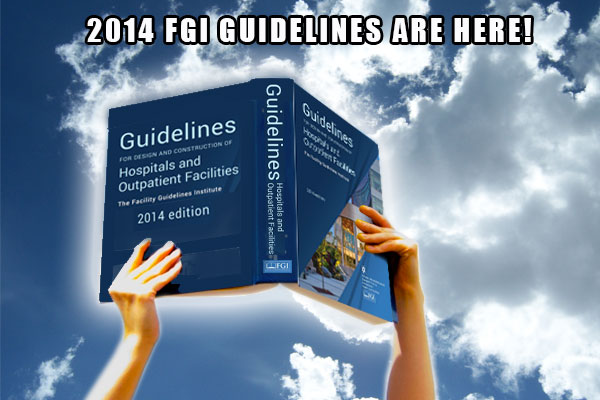The new version of the FGI (Facility Guidelines Institute’s) Guidelines is here! The “FGI Guidelines” is an industry standard document focused on the design and construction of healthcare facilities, covering topics from space planning and room design to equipment, to (you guessed it) acoustics, which was introduced in the 2010 cycle.
The influence of the Guidelines is huge. Forty-two states use them in some form as part of their building codes. They are cited in sixty countries. The acoustic design requirements are the only comprehensive acoustical criteria for healthcare facilities written in code language, and serve as the sole reference for acoustical criteria in ICC, LEED for Health Care, and others.
The impact of the guidelines is no-less important. Hospitals can actually lose some of their Medicare and Medicaid funding, based on their HCAHPS scores. The HCAHPS (Hospital Consumer Assessment of Healthcare Providers and Systems) survey is a national, standardized, publicly reported survey of patients’ perspectives of hospital care. The portion of the survey covering “quiet” is typically the lowest scoring section. Improvements to a hospital’s acoustics score, can ensure their full incentive-based funding. The 2010 and now 2014 FGI Guidelines provide hospitals and other healthcare facilities the acoustical targets necessary to help improve quiet, which in-turn promotes rest and healing, and in-turn can improve the HCAHPS scores.
In order to stay current with the latest research and changes in healthcare laws, the Guidelines are edited and re-issued every four years following an open, formal, Continual Improvement Process. This work is done by the FGI’s Health Guidelines Revision Committee (HGRC), which is composed of a multi-disciplinary group of experts related to healthcare facilities. The acoustical content is the responsibility of the FGI Acoustics Working Group (AGW), a standing committee, formed in 2005. Kenric Van Wyk, serves as the Education Chair of the group, which also includes members of the Acoustical Society, INCE-USA, and other professional organizations. The AGW authors and edits the Sound & Vibration Design Guidelines for Health Care Facilities (S&V-3.0-2014), which serves as the sole acoustical reference for the FGI Guidelines.
The specific acoustical design criteria in both volumes of the Guidelines are presented in terms of “minimum standards,” and cover the following categories:
- Site exterior noise
- Acoustic surfaces
- Room noise levels
- Performance of interior wall and floor/ceiling constructions
- Speech privacy
- Building vibration
Look for more details about all those criteria in an upcoming post. You might also invite Acoustics By Design to visit your location as part of the Sound HealthCare 2014 tour.
One of the largest and most visible changes, from the 2010 cycle, is the split of the Guidelines from a single document into two volumes:
- Guidelines for the Design and Construction of Hospitals and Outpatient Facilities
- Guidelines for the Design and Construction of Residential Health, Care, and Support Facilities
Both volumes contain specific acoustical criteria for their respective facilities.
Also new to the 2014 cycle, is the safety risk assessment. The assessment works to evaluate and mitigate potential causes of adverse safety events in healthcare facilities due to the built environment. Notably, the 2014 Guidelines have formally identified acoustics as a life-safety issue. Design guidelines have been set for these spaces to address evidence that sound and noise affects the rate of medication errors. In addition, the Guidelines highlights alarm fatigue. This desensitization to constant monitoring equipment alarms can lead to dangerous behavior by staff, and can cause loss of sleep and an increase in anxiety in patients.
Working with an independent acoustical consulting firm, like Acoustics By Design, is the best way to ensure new construction and remodeling of healthcare facilities take full advantage of the standards found in the 2014 FGI Guidelines.
